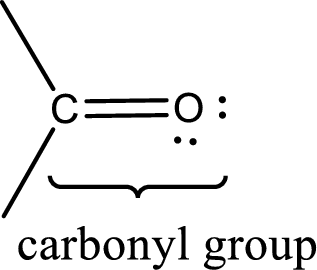
Concept explainers
Interpretation:
The compound in which nitrogen atom is bonded directly to the carbonyl carbon atom has to be chosen from the given options.
Concept Introduction:
Carbonyl groups are the one which contain a double bond between carbon and oxygen atom.

The groups that are attached to the carbonyl carbon atom can be either hydrogen or carbon atom or heteroatom. If the attached atoms are hydrogen and a carbon atom means then the compound is an aldehyde and if they are two carbon atoms means then the compound is a ketone. If a nitrogen atom is attached to the carbonyl carbon atom, it is known as amide.
Want to see the full answer?
Check out a sample textbook solution
Chapter 15 Solutions
EBK GENERAL, ORGANIC, AND BIOLOGICAL CH
- Based on the picture, which of the following functional groups is found in molecules #8? A. Amino B. Phosphate C. Methyl D. Thiolarrow_forwardWhich of the following bonds is/are likely to be polar (choose all that apply)? a. H-H b. O-H c. C-H d. O-Oarrow_forwardWhich of the following is the functional groups of carbohydrates? A. Carboxyl groups B. Aldehyde and Ketone groups C. Alcohol and Carboxyl groups D. Hydroxyl groups and Hydrogen groupsarrow_forward
- Which of the following compounds would be most soluble in carbon tetrachloride, CCl4? a. NH3 d. CH3OHb. H2O e. C6H6c. HClarrow_forwardin dehydration reaction between phosphate (derived from phosphoric acid) and glycerol (a sugar alcohol) accompanied with the removal of a water molecule, what chemical bond holds them together in a phospholipid molecule? A. Ether Alcohol B. Thioester Bond C. Acid Anhydride/Phosphoanydride bond D. Ester Bondarrow_forwardHydrolysis of a mixture of glycerophospholipids may yield the following, EXCEPT: A. Galactose B. Choline C. Serine amino acid D. Phosphatearrow_forward
- Indicate whether each of the following statement about enantiomers is True or False. a. Enantiomers always have the same molecular formula. b. Enantiomers always have the same structural formula. c. Enantiomers are always nonsupetrimposable mirror images of each other. d. Enantiomers always differ in handedness.arrow_forwardWhich of the following sugars do not have asymmetric centers? A. Fructose B. Glyceraldehyde C. Sedoheptulose D. Dihydroxyacetone E. Glucuronic acidarrow_forwardWhat are the functional groups that can be found in the molecule? A. Ether, secondary amine, alkene (Ether, amina sekundar, alkena) B. Ether, primary amine, alkene (Eter, amina utama, alkena) C. Ether, amide, alkene (Eter, amida, alkena) D. Ester, primary amine, alkene (Ester, amina utama, alkena)arrow_forward
- Indicate whether each of the following descriptions concerning the molecule sphingosine is true or false. a. Carbons 1, 2, and 3 all bear the same kind of functional group. b. Three different kinds of functional groups are present. c. It is an unsaturated diaminoalcohol. d. The carbon chain contains 20 carbon atoms.arrow_forwardIndicate whether each of the following statements about the structural characteristics of monosaccharides is true or false. a. An aldehyde group or a ketone group, but not both, is always present. b. A hydroxyl group must be present on each carbon atom.arrow_forwardClassify the following lipid (choose all that apply).CHOOSE ALL THAT APPLY a. monounsaturated b. omega-6 c. triglyceride d. saturated e. steroid f. polyunsaturated g. omega-3 h. wax ester i. fatty acidarrow_forward
 Human Biology (MindTap Course List)BiologyISBN:9781305112100Author:Cecie Starr, Beverly McMillanPublisher:Cengage Learning
Human Biology (MindTap Course List)BiologyISBN:9781305112100Author:Cecie Starr, Beverly McMillanPublisher:Cengage Learning
